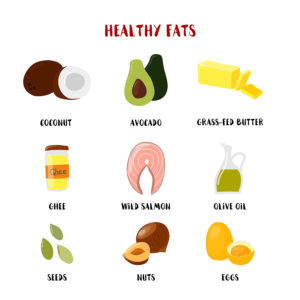 Which kind of fats are healthy for seniors? What’s the difference between good fat and bad fat? Even if I did study chemistry in college (a long time ago), I’m not sure I know what’s best for my diet. To make matters worse, the experts change opinions and don’t agree. But healthy seniors need to get informed. There is a difference between good fat vs bad fat.
Which kind of fats are healthy for seniors? What’s the difference between good fat and bad fat? Even if I did study chemistry in college (a long time ago), I’m not sure I know what’s best for my diet. To make matters worse, the experts change opinions and don’t agree. But healthy seniors need to get informed. There is a difference between good fat vs bad fat.
Most nutritionists agree that cutting out fat or eating a low fat diet is not the answer to losing weight or optimal health. I discussed some reasons for this previously. The real culprit in the battle of the bulge is too many processed carbohydrates, along with processed oils, especially “partially hydrogenated” trans fats. Those two evil twins lead to being overweight, heart disease, cancers, diabetes, and most of the chronic diseases of aging.
Cut Out Vegetable Oils
However, there are a variety of fats our bodies need for optimal performance, some better than others. To make it less complicated, I try to stay away from processed fats, anything that comes out of a factory in a box or can. Especially vegetable oils.
For a long time, they believed that saturated fats were the bad guys. Most health sites caution us to limit food with high saturated fats (red meat, dairy). My rule of thumb is that most of my protein comes from fish and chicken, and red meat is an occasional treat.
Dairy Fats
I seem to have trouble digesting grains so I don’t eat bread or pasta very often. If I can find something gluten free that suits my system better, I’ll opt for that. I’m lactose intolerate, so I use milk in my coffee of the lactose-free variety. I eat cheese and yogurt (without sugar) and don’t seem to have problems.
My rule is not to eliminate anything completely, as long the source of nutrition is natural (comes from an animal or plant). I think most health sites makes things overly complicated with their descriptions of saturated, monounsaturated, and polyunsaturated fats. Nevertheless, here are some descriptions.
Good Fat – Unsaturated (Poly & Mono)
- Lowers rates of cardiovascular and all-cause mortality
- Lowers bad cholesterol & triglyceride level
- Provides essential fats your body needs but can’t produce itself
Find these fats in:
- Fish: Eat at least 8 ounces of non-fried fish twice each week, which may be divided over two 3.5- to 4-ounce servings. Choose fatty or oily fish like albacore tuna, herring, lake trout, mackerel, sardines and salmon to get essential omega-3 fatty acids.
- Nuts: Add a small handful (about 1 oz.) of unsalted nuts and seeds to salads or steel cut oats or enjoy them on the go for energy, protein and fiber. Good choices include almonds, hazelnuts, peanuts, pistachios, pumpkin seeds, sunflower seeds and walnuts.
- Avocado: Slice, dip or smear it on add healthy fat, fiber and essential vitamins and minerals.
- Cooking oils: Don’t forget to use olive oils and others that are not processed vegetable oils like canola and corn. Good choices include avocado, grapeseed, olive, sesame, soybean and oils.
Bad Fats: Artificial Trans Fat, and Hydrogenated Oils
- Increases risk of heart disease
- Raises bad cholesterol levels
Trans fat, also called unsaturated fatty acids or trans fatty acids, are a type of unsaturated fat that occur in small amounts in nature, but became widely produced industrially from vegetable fats starting in the 1950s for use in margarine, snack food, packaged baked goods, and for frying fast food. Trans fat has been shown to be associated consistently, in an intake-dependent way, with increased risk of coronary artery disease, a leading cause of death in Western nations.
Saturated fats occur naturally in many foods. The majority come mainly from animal sources, including meat and dairy products. American Heart Association (heart.org) recommends limiting saturated fats:
- Fatty beef
- Lamb
- Pork
- Poultry with skin
- Beef fat (tallow)
- Lard and cream
- Butter
- Cheese
- Dairy products made from whole or reduced-fat (2 percent) milk.
Many baked goods and fried foods can contain high levels of saturated fats. Some plant-based oils, such as palm oil, palm kernel oil and coconut oil, also contain primarily saturated fats.
Ketogenic Diet
Switching to fat for fuel (ketogenic diet) not only is healthy, but is recommended for people with cancer, seizures, and other chronic diseases. It promotes mitochondrial health, reduces oxidative stress and inflammation, and delays aging.
Athletes find they can prolong training and recover quickly. Best of all, when the body switches to burning fat for fuel, the brain thrives. For me, by adding more protein to my diet, eliminating sugar, wheat, pasta, and unnecessary carbs, and eating olive oil and avocados and nuts, my body fat dropped from 28% to 26% and muscle increased―finally!
It’s up to every senior to find a diet that works for him or her and which is satisfying. If your diet doesn’t appeal to your palate, digestive system, and give you good energy, you won’t last long. You will soon go back to eating whatever you can find that’s convenient and yummy. That means bad fats in packaged foods, fast food, snacks and pastries.
Take a stance and fight back. Don’t let the food industry dictate your diet. Winning the War on Aging means finding the right meals that work for your cells and brain.

Recent Comments